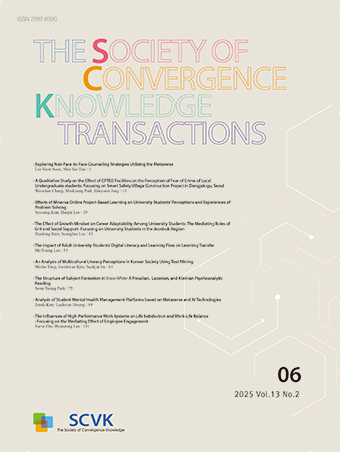Research Article
Abstract
References
Information
SNS의 사용의 증가와 스마트폰의 확대로 비대면 커뮤니케이션에서 친숙한 표현기호로서의 이모티콘은 다양한 감정 전달과 의사소통의 보조 수단으로서 널리 사용되어 지고 있다. 이모티콘 스타일 디자인에 관한 실증조사를 통해 이모티콘 그래픽 요소에 대한 중요도 및 이모티콘 스타일에 대한 선호도 등을 분석한 결과 남성은 타이포 그래픽요소와 재미있는 스타일, 스타, 방송 스타일의 이모티콘을 더 중요하게 인식하고 , 여성은 동물 이모티콘 그래픽 스타일에 높은 선호도를 가지고 있으며, 단순 그래픽과 귀여운 스타일은 낮은 연령에서 선호하는 것으로 나타났다. 반대로 채색 그래픽은 연령대가 높을수록, 실사 이미지는 중고교 재학 중인 10대와 50대 이상에서 다른 연령대보다 높은 선호도를 보이고 있었다. 또한 재미있고 메시지가 있는 스타일과 스타 및 방송, 만화 ,웹툰 스타일은 40대와 50대 이상에서 높은 선호도를 나타냈으며 채색 그래픽과 타이포 그래픽은 대학원 재학 중 이나 대학졸업자 들에게 높은 선호도를 보이고 있으며 메시지가 있는 스타일은 대학 재학생들의 선호도가 비교적 낮게 나타났다. 스타 및 방송 스타일에서는 중고교 재학생들이 다른 집단보다 높은 선호도를 보이는 것으로 나타났다. 채색 그래픽에서는 자영업 종사자가 다른 직업군보다 높은 선호도를 나타냈으며, 실사 이미지와 타이포 그래픽은 주부가 다른 집단보다 높은 선호도를 보이고 있었다. 이러한 실증분석을 통해 제시된 결과가 이모티콘 디자인 개발의 기초자료로 활용되여.이모티콘 캐릭터 시장의 활성화에 도움이 되길 기대해 본다.
With the increasing use of smartphones and SNS, emoticons as familiar expression symbols in non-face-to-face communication have been widely used as an auxiliary means of communication of various emotions. Through an empirical research on emoticon style design, we analyzed the importance of emoticon graphic elements and the preferences of emoticon style. Men consider more important of typographic elements, funny styles, and emoticons of star and broadcast style, women have a higher preference for animal graphic style emoticons, and simple graphics and cute styles are preferred at lower ages. On the contrary, the colored graphics are preferred as the age group gets higher, and the photo images are preferred in the teenagers and over 50s. Their 40s and over 50s showed high preferences in funny message, star, broadcast, cartoon, and webtoon styles. Graduate students and university graduates showed high preferences in colored graphics and typographical styles, and the message style was preferred relatively low for undergraduate students. In the star and broadcast styles, middle and high school students showed higher preference than other groups. Self-employed workers showed higher preference in colored graphics than other occupation groups, and housewives showed higher preference in photo images and typographies. We expect that the results presented through this empirical analysis will be used as basic data for emoticon design development and will help to vitalize the emoticon character market.
- https://www.doopedia.co.kr/doopedia/master/master.do?_method=view&MAS_IDX=101013000877173
- 김우룡, 장소원 “비언어적 커뮤니케이션” , 나남출판, p. 478, 2004.
- 차윤수, 최혜림, 오예림, 장미경 “동·서양 이모티콘의 차이점 연구”, 조형미디어학, 15권, 4호, 한국일러스아트학회, pp. 234-235, 2012.
- 이승영 “모바일 메신저 이모티콘과 브래드 이모티콘의 동일시에 관한연구”, 한국디자인문화학회지, 제24권 제1호, pp. 484, 2018.
- 김선진 “모바일 메신저의 이모티콘 특성에 관한 비교 연구”, 디지털디자인학연구, 제14권 제1호, pp. 87-96, 2014.
- Publisher :The Society of Convergence Knowledge
- Publisher(Ko) :융복합지식학회
- Journal Title :The Society of Convergence Knowledge Transactions
- Journal Title(Ko) :융복합지식학회논문지
- Volume : 7
- No :4
- Pages :115-124
- DOI :https://doi.org/10.22716/sckt.2019.7.4.057




 The Society of Convergence Knowledge Transactions
The Society of Convergence Knowledge Transactions







